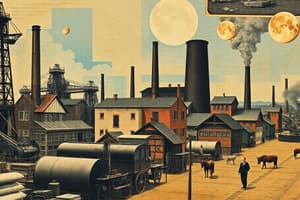Podcast
Questions and Answers
What was a characteristic that helped bring about the Industrial Revolution in England?
What was a characteristic that helped bring about the Industrial Revolution in England?
plentiful supplies of iron and coal
Which industry launched the Industrial Revolution?
Which industry launched the Industrial Revolution?
textile
Which invention helped the textile industry move from homes to factories?
Which invention helped the textile industry move from homes to factories?
Arkwright's water frame
Which steam-powered method of transportation quickly outpaced earlier forms for transporting goods and people?
Which steam-powered method of transportation quickly outpaced earlier forms for transporting goods and people?
Which source of power was introduced in the late 1800s?
Which source of power was introduced in the late 1800s?
Which production method emerged during the Second Industrial Revolution?
Which production method emerged during the Second Industrial Revolution?
Which best describes one outcome of Henry Ford's method of production?
Which best describes one outcome of Henry Ford's method of production?
What is a corporation?
What is a corporation?
Which was not a result of industrialization?
Which was not a result of industrialization?
Which best explains the rise of the middle class during the Industrial Revolution?
Which best explains the rise of the middle class during the Industrial Revolution?
Flashcards are hidden until you start studying
Study Notes
Industrial Revolution Characteristics
- Plentiful iron and coal supplies were crucial for initiating the Industrial Revolution in England.
Textile Industry Significance
- The textile industry was the first to launch the Industrial Revolution, driving early industrial growth.
Innovations in Textile Production
- Arkwright's water frame was an essential invention that transitioned textile production from home-based setups to factories.
Transportation Advancements
- Railroads, as a steam-powered transportation method, significantly improved the speed of moving goods and people compared to previous methods.
Emergence of New Power Sources
- The late 1800s saw the introduction of electricity as a new source of power, transforming industrial processes.
Production Methods Evolution
- The assembly line emerged during the Second Industrial Revolution, revolutionizing manufacturing efficiency.
Impacts of Henry Ford's Production Method
- Henry Ford's production method reduced the time required to build products, subsequently leading to lower costs for consumers.
Understanding Corporations
- A corporation is defined as a business entity owned by a group of investors who collectively share the profits and losses incurred.
Industrialization Effects
- The slave trade was not a result of industrialization, highlighting a key distinction in economic changes during this period.
Rise of the Middle Class
- The rise of the middle class during the Industrial Revolution was driven by the demand for skilled and educated managers and office workers in factories.
Studying That Suits You
Use AI to generate personalized quizzes and flashcards to suit your learning preferences.





